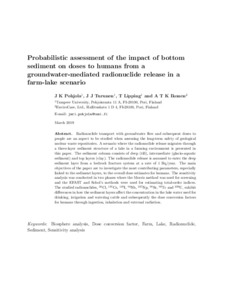Probabilistic assessment of the impact of bottom sediment on doses to humans from a groundwater-mediated radionuclide release in a farm-lake scenario
Pohjola, Jari; Turunen, Jari; Lipping, Tarmo; Ikonen, Ari (2019-05-03)
Pohjola, Jari
Turunen, Jari
Lipping, Tarmo
Ikonen, Ari
03.05.2019
Julkaisun pysyvä osoite on
https://urn.fi/URN:NBN:fi:tuni-202012219080
https://urn.fi/URN:NBN:fi:tuni-202012219080
Kuvaus
Peer reviewed
Tiivistelmä
Radionuclide transport with groundwater flow and subsequent doses to people are an aspect to be studied when assessing the long-term safety of geological nuclear waste repositories. A scenario where the radionuclide release migrates through a three-layer sediment structure of a lake in a farming environment is presented in this paper. The sediment column con- sists of deep (till), intermediate (glacio-aquatic sediment) and top layers (clay). The radionuclide release is assumed to enter the deep sediment layer from a bedrock fracture system at a rate of 1 Bq yr−1. The main objectives of the paper are to investigate the most contributing parameters, especially linked to the sediment layers, to the overall dose estimates for humans. The sensitivity analysis was conducted in two phases where the Morris method was used for screening and the Extended Fourier Amplitude Sensitivity Testing and Sobol’s methods were used for estimating total-order indices. The studied radionuclides, 36Cl, 135Cs, 129I, 94Nb, 237Np, 90Sr, 99Tc and 238U, exhibit differences in how the sediment layers affect the concentration in the lake water used for drinking, irrigation and watering cattle and subsequently the dose conversion factors for humans through ingestion, inhalation and external radiation.
Kokoelmat
- TUNICRIS-julkaisut [16944]
